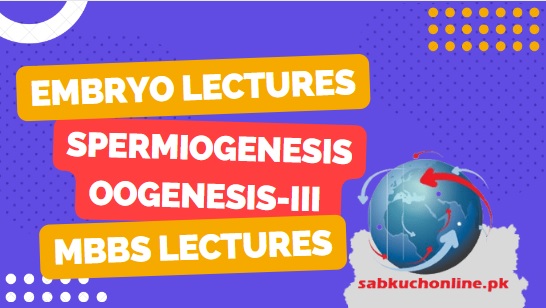Specific learning objectives:
By the end of this session you should be able to:
- Explain the process of SPERMIOGENESIS
- Enlist the differences between spermatogenesis and spermiogenesis
- Justify the relationship of sub-fertility with production of abnormal sperms
- Define terms like azospermia, oligospermia
- Describe the maturation of oocytes before birth
Spermiogenesis refers to the differentiative process by which spermatids are transformed into spermatozoa.
The main features of this transformation include:

Sperm



- Important organelles are present in spermatid; there is a prominent Golgi apparatus, a pair of centrioles and numerous mitochondria.
- The formation of a spermatozoon involves elaborate changes in all these cellular elements.
- The Golgi apparatus shifts its position to come to lie close to the nucleus. Eventually, it gives rise to a large vesicle, called acrosome, which becomes applied to one pole of the nucleus in the form of a cap. The acrosomal material is rich in carbohydrates and contains hydrolytic enzymes.
- The nucleus itself gradually moves toward the cell membrane, becomes progressively condensed and assumes a slightly flattened and elongated shape. The nucleus and the overlying acrosomal cap migrate to a position adjacent to the cell membrane.

- The area occupied by the nucleus and acrosomal cap becomes the head region of the developing spermatozoon.
- As the acrosome is forming, the two centrioles move to the caudal pole of the nucleus. In this location one of them, called distal centriole, gives rise to a flagellum which forms the axial filament of the developing sperm tail.
- The cell gradually elongates; this elongation occurs due to the displacement of the cytoplasm caudally.
- The mitochondria gradually move toward the caudal region of the cell, partially fuse to one another and finally form a sheath around the proximal part of the flagellum.
- The area containing the mitochondrial sheath comes to be known as middle piece of the sperm .

- In the final stages of the maturation of the spermatid, the surplus (residual) cytoplasm is partitioned off from the remainder of the spermatid.
- When the sperm is released from the seminiferous epithelium, the excess cytoplasm becomes detached from the sperm as a membrane-bound structure called residual body which is phagocytized by the Sertoli cells.
- The end piece of the sperm tail finally consist mainly of the axial filament (flagellum) surrounded by the plasma membrane.
- The net result of these changes is that a fully developed spermatozoon:
- (i) attains a very small size,
- (ii) it is capable of achieving motility, and
- (iii) it retains only those cellular structures which are essential to make it capable of fertilizing an ovum.






Morphological Abnormalities
- It is extremely rare to find an abnormality of shape in the female gametes (ova).
- However, morphological abnormalities of spermatozoa are quite common and presence of 10% abnormal spermatozoa in the semen is considered to be normal.
- Radiography, severe allergic reactions, & certain antispermatogenic agents increase the %age of abnormal shaped sperms (affect fertility if no. exceeds 20%)
- Several types of morphological abnormalities of spermatozoa are known; the commonly found abnormalities include:
- two tails,
- two heads,
- very small head (called pinhead),
- very large head, and
- abnormal alignment of head and tail, etc.
- Relationship of sub-fertility with abnormal sperms?
- Abnormal spermatozoa are incapable of fertilizing an ovum.

Sperm counts
- Sperms accounts for less than 10% of the semen
- Remainder consists of secretions of the seminal glands, prostate & bulbourethral glands.
- Usually more than 100 million sperms per ml of semen
- A man with 20 million sperms/ml or 50 million/ejaculate is fertile
- A man with less than 10 million sperms/ml is likely to be sterile, especially when the sperms are abnormal & immotile
- For potential fertility, 50% of sperms should be motile after 2hrs & some should be motile after 24 hrs.
- Male infertility may result from low sperm count (oligospermia), poor sperm motility, medications, endocrine disorders, exposure to environmental pollutants, cigarette smoking, abnormal sperms or obstruction of genital tract & accounts for 15% to 30% of infertility in couples.
- Oligospermia: Presence of very few live sperms in the ejaculate
- Azospermia: Absence of live sperms in the semen
Oogenesis
The process whereby oogonia differentiate into mature oocytes.
OOGENESIS Site?/
Ovaries


OOGENESIS
- The process whereby oogonia differentiate into mature oocytes.
- In the female, the primordial germ cells differentiate into oogonia.
- PGCs originate in the endoderm of yolk sac during the 4th week of development.
- From here, they migrate to and settle down in the developing ovaries.
- In the ovaries they pass through a phase of proliferation in which they increase in number by a series of mitotic divisions.
PRENATAL MATURATION OF OOCYTE
4th wk i.u.l.: PRIMORDIAL GERM CELLS, 20-30 in number, 12-20 um,
5th-12th wk i.u.l.: OOGONIA, Mitosis, arranged in clusters surrounded by a layer of flat epithelial cells which originate from surface epithelium. All of the oogonia in one cluster are probably derived from a single cell.
12th wk to 5th month i.u.l.: Mitosis continues,
5th Month i.u.l.: Max No. 7000,000/ovary, then cell death begins, some oogonia enlarge to form PRIMARY OOCYTES
All surviving PRIMARY OOCYTES (approx. 100um) are surrounded by a single layer of flat follicular cells forming primordial follicle (cytophysiological unit, and have entered prophase of meiosis-I but arrested at diplotene (dictyotene starts)
Arrested state is produced by oocyte maturation inhibitor (OMI), a small peptide secreted by follicular cells

Prenatal maturation of Oocyte


Postnatal maturation of Oocyte

Differences between Spermatogenesis & Spermiogenesis

